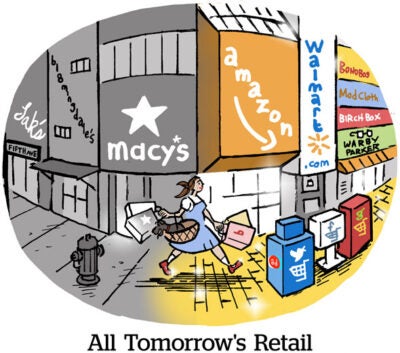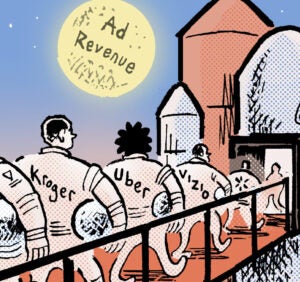The 25-year-old cosmetics brand Milani is one of the only independent makeup companies to compete in the mass-market retail category.
The company combines the old-school retail world with the new world of digital-native marketing.
One example of this hybrid approach could be found in the company’s big marketing and product development pushes of the past year, Milani CMO Jeremy Lowenstein told AdExchanger. Last year, he said, the company launched blurring powders that give a filtered look, similar to in-app filters. The idea was inspired by and lived organically on social channels, but was meant to drive mass-market, in-store shelf sales. With new product launches this year, Milani has expanded on its blurring and blur-out products.
AdExchanger caught up with Lowenstein about Milani’s strategy and how it fits into the mass-market retail category, in contrast to DTC and social-based brands.
AdExchanger: What is the product launch calendar for you?
JEREMY LOWENSTEIN: Most [beauty] brands launch innovation twice a year. The bulk of that innovation happens in January in the first quarter, just based off retailer planogram resets (planograms are visualizations of store shelf layouts that retailers use for planning), and then most brands do a minor reset in the second half.
When you say “innovation,” do you mean new product launches or some kind of investment?
Yes, new product launches. Those typically happen in Q1.
Unlike when you think of Sephora, for example, for prestige brands. They can launch anytime. There are fewer doors – 1,000 to 2,000 doors for Sephora at this point – whereas Milani is in full distribution of Ulta, Walmart, Target, Walgreens, CVS. Those major retailers only reset the color cosmetics set in store one major time a year in the first quarter, and then they’ll do minor updates in the second half.
It’s very labor-intensive, given we’re in 25,000-plus stores in the US.
What’s your media mix?
We play across all the channels. We do everything from paid social, paid search, streaming, retail media networks, and then within the DSP world of Amazon. And influencers remain a healthy part of our go-to-market strategy.
We do try to touch everywhere we can.
For the retail media networks you work with, to what degree is that just preexisting shopper marketing with them or something really new they’re bringing to the table?
I’ve been doing this, marketing in the beauty space, for a long time. All of these retailers always had some sort of brand integration or activation opportunities, whether it was sponsoring beauty advisors at Walgreens on the floor or training and development for the Ulta beauty advisors on new product.
They’ve all clearly accelerated their paid media footprints, too, as their dot com businesses become more important. I’d say there are some retailers who are more advanced than others, depending on their own life cycle within those developments. Ulta, Roundel and Walmart Connect have been doing this for years, and I’d say they are at the forefront. A lot of them have had sponsored search as part of their media mixed opportunities for a while now.
What’s the approach to creative and targeting when you have a product launch across all those retailers?
When I look at launching a campaign, everything has to fire on all cylinders. Whether you call it full funnel or say there’s no funnel anymore, it has to be a holistic approach and at every touch point.
When the consumer is on Target.com and they’re looking for a tinted moisturizer, how do ads show up from the Roundel network that support Milani? If they’re searching online, are our products showing up in searches? Are shoppers in the social universe having Milani show up with the right content at the right time, whether it be for entertainment purposes or education purposes?
What do you see in terms of shopping on social nets like TikTok and Instagram?
I separate those things, the sales from the [on-platform] shopping. Our social media is driving sales, yes, but those sales are happening mostly in stores or online through those retailers.
Then there’s the social commerce piece of it.
TikTok Shop, yes, we are on there as well. It’s more of an affiliate-based network. But where I see most of the strengths happening today is within Amazon and the classic brick-and-mortar retailers, given their size and accessibility. I think, if you look at the prestige category or you look at devices in the skin care world – the red light therapies and oral care – that’s what you see doing quite well on TikTok Shop.
Because, again, you’re looking at affiliates that are a commission-based structure. And when your average price point in mass-market color cosmetics (Milani’s category) is around $11, you have to consider, for the influencer, where do they see their most opportunity to drive commission?
How much is your marketing and new product development about delivering on a retailer’s goals – like, if a store says it wants to see a particular demo – say, more women aged 18-35?
When I think about Milani, our primary purpose is to deliver prestige, quality products at an affordable price point. So sometimes that also means coming out at an average higher price point than what you typically see in a mass retailer. Some of my competitors are an average price point of $6-$8; we’re in the $10-$12 range.
When we layer that into a retailer strategy, we then say, “This is where we can bring incremental consumers into your store.”
I’ll give you a specific retailer objective: Vinima, who’s Walmart’s head of beauty [Vinima Shekhar, Walmart VP of merchandising for the beauty category], has been saying, “How do you build a prestige shopper at Walmart?”
Whether it’s tariffs, inflation or whatever else, they’re seeing people with $100,000+ average household income coming into Walmart. So Walmart is asking, “What are the brands that speak to those shoppers?”
And we are that brand for them, because we know we appeal to that consumer. This is where we fit into the retailer strategy.
















